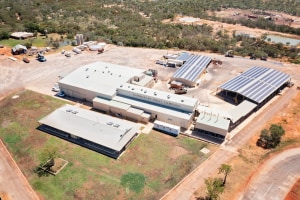Recycling your small cartons can make a big impact. By returning beverage cartons through container deposit schemes, Australians can help keep valuable materials in use while supporting our recycling system.
This National Recycling Week (10–16 November), Planet Ark is highlighting the many benefits of using Australia’s growing network of Container Deposit Scheme (CDS) drop-off points, particularly for beverage cartons under one litre in size, like juice, iced coffee and flavoured milk.
Tetra Pak, a long-term supporter of National Recycling Week, is encouraging Australians to take advantage of CDS so more cartons can be recovered cleanly, efficiently and turned into high value new products.
How container deposit schemes deliver better recycling outcomes
While kerbside recycling plays a critical role, container deposit schemes provide some additional advantages – especially for smaller beverage cartons.
Cleaner, higher-quality recycling streams: CDS material is sorted separately from other household recyclables, resulting in significantly lower contamination. This means materials can be processed more efficiently, with greater recovery rates.
Financial reward: All schemes around Australia offer a 10c refund per eligible container, which builds a positive behaviour loop and drives higher return rates. This is a useful means for community groups and sports clubs to fundraise, members of the public to make additional income and charities to earn donations.
Supports local circular economy jobs: CDS infrastructure creates regional processing roles, logistics jobs, and supports new manufacturing markets here in Australia, not just offshore commodity trading.
Better user experience: Drop off points are becoming more widespread and convenient (supermarkets, shopping centres, charity depots), reducing barriers to participation.
Australia’s expanding network of CDS collection points is helping increase recovery of beverage cartons that would otherwise be lost to landfill or contamination in kerbside streams.
Where can cartons be returned?
Rules differ slightly by state and territory, but a general rule of thumb is that all beverage cartons under one litre in volume can be recycled through the relevant container deposit scheme in your state. Here’s the current breakdown:

Some states are also widening the eligibility thresholds of their container deposit schemes to include larger-volume containers. For example, the Western Australian scheme has indicated that once its planned mid 2026 expansion takes effect, almost all beverage containers between 150 mL and 3L will qualify for the 10c refund. In the ACT, the scheme already covers most beverage containers up to 3L, although plain milk and larger pure-juice containers remain excluded. Northern Territory will be expanding their scheme in 2026 to cover all sizes and all products in a carton.
These steps signal a move toward broader inclusion of volume sizes, including cartons over 1L, which would help further boost carton returns and make it easier for industry and consumers to align on a more consistent national standard.
What happens to the cartons afterwards?
Once deposited, cartons go to specialist recyclers, including saveBOARD’s state-of-the-art recycling facility. Here, cartons, along with other recovered materials, are processed and upcycled into what saveBOARD describes as a “low-carbon alternative” to plasterboard-style building materials.
These boards can be used in both residential and commercial construction projects, helping close the loop locally and avoid extracting virgin resources for new building products. This is a circular economy solution happening here in Australia, driven by the simple act of returning your beverage carton to a container deposit scheme.
Why beverage cartons are one of the most sustainable packaging choices
A life cycle assessment by Thinkstep-anz for Tetra Pak has found that cartons continue to have the lowest carbon footprint across all beverage packaging categories in Australia.
The study shows that the production stage has the most significant impact on the carbon footprint of beverage packaging and the mass of packaging and component materials also has a major influence. By the time a product reaches the point of recycling or disposal, most of its environmental impact has already occurred. That means reducing environmental impact needs to start at the very beginning of the value chain, focusing on the choice of raw materials and where and how the packaging is manufactured.
Sustainability requires full circle thinking and the biggest environmental benefits are generally derived from making changes in material production. Most of the environmental footprint of beverage packaging comes from how it’s made and what material is used, not how it’s disposed of, meaning choosing low-emission, renewable materials matters more than ever.
Beverage cartons help achieve this by being mostly made from renewable paper fibre, meaning very little material is needed to safely package food and beverages, while keeping carbon emissions significantly lower across the entire life cycle.






